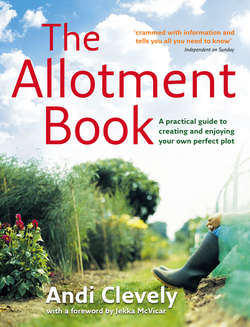Читать книгу The Allotment Book - Andi Clevely - Страница 13
BOUNDARIES & PATHS
ОглавлениеThese are important, and establish the plot’s shape and means of access.
The edges of your plot could simply be paths or lines on the ground, or a previous tenant may have arranged something more elaborate. However, comprehensive fencing of any kind is inappropriate and a waste of ground; it may also possibly contravene site rules.
A useful way to define boundaries is to make natural boundaries, such as training fruit on posts and horizontal wires (see page 147), which can be very productive while occupying little space. Free-standing fruit bushes or seasonal hedges of runner beans, Jerusalem artichokes, sunflowers or herbs like angelica can confer privacy and relief from wind, perhaps screening an area for a sheltered seat.
There may only be one or two existing paths, dividing your plot from those next door. As these will probably be shared, any changes, improvement or maintenance should be negotiated with neighbours.
Paths within the plot are your exclusive responsibility. For practical purposes, main paths usually need to be straight, weather-proof, wide enough for comfort, and run directly between important points. Subsidiary paths (between beds, for example) can be narrower, even temporary arrangements, planned to allow access to cultivate and tend the various areas.
The material used will vary from plot to plot, although some sites are laid out with a grid of permanent paved paths. They will often be made of grass, which needs mowing or trimming periodically, while trampled earth is sufficient to allow simple maintenance between beds – protect those on wet ground with sacking, bark or waste timber slats. Paving slabs are the best long-term solution, or you could use gravel spread about 5cm (2in) deep on top of a weed-suppressant membrane (but beware: deep or smooth gravel can impede laden wheelbarrows).
